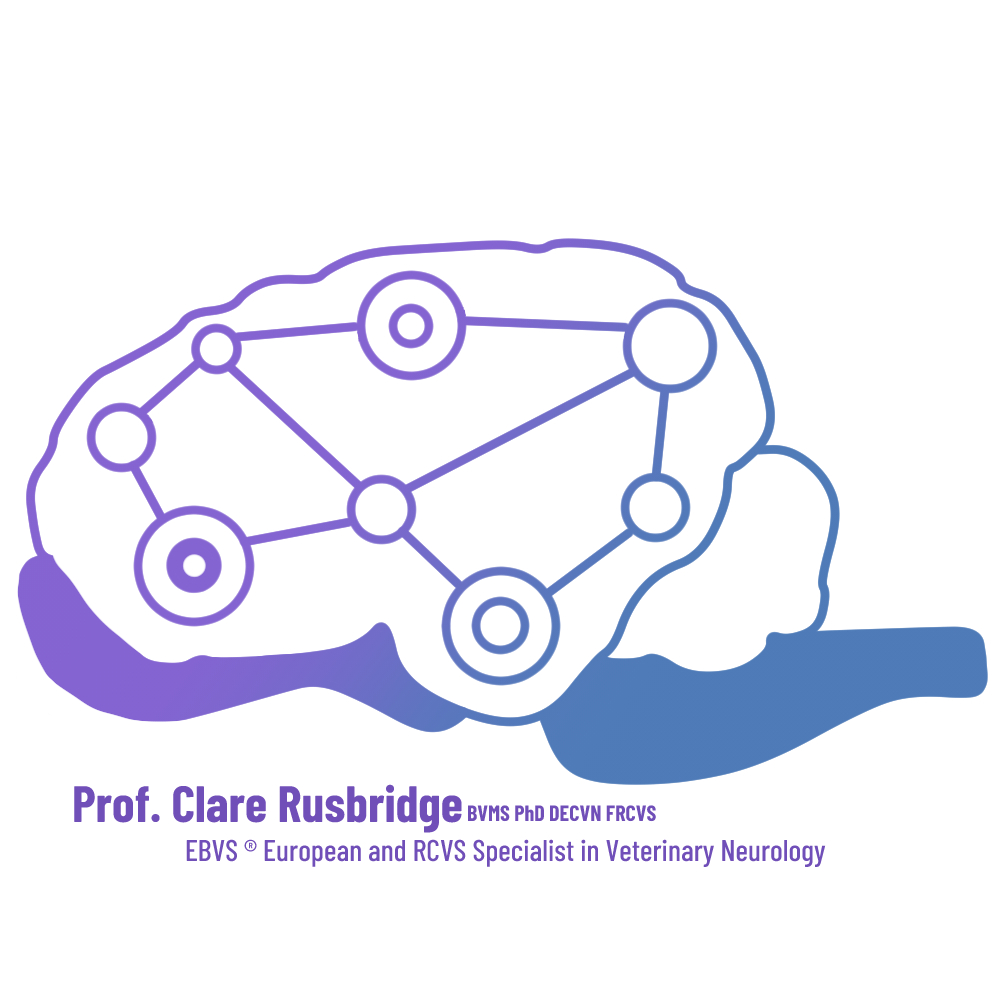
Treatment Algorithm 2025 - Canine Chiari and Syringomyelia
University of Surrey Ref: Prof Clare Rusbridge, Professor in Veterinary Neurology
How to use this page
- The Canine Chiari and syringomyelia treatment algorithm is now supported by many YouTube videos (some listed at the end of the document)
- You can access the videos by clicking on underscored words → Click!
- The Canine Chiari and syringomyelia treatment algorithm is also supported by Chiari-Check. A diagnostic tool which generates a Chiari-pain and SM-score to help determine if Canine Chiari or syringomyelia is likely before an MRI scan (or if MRI not possible) and ultimately to monitor clinical signs. → Chiari-Check
- Chiari-Check is still under development developed and will improve in accuracy in time
- The Canine Chiari and syringomyelia treatment algorithm is intended for veterinary surgeons and drugs should only be prescribed under the care of a veterinary surgeon
- Please refer to your national guidelines - gabapentinoiddrugs and CBD oil are controlled in many countries and all the drugs indicated in the algorithm are being used off label and care givers should be advised accordingly
- The video explaining the CMSM treatment algorithm can be accessed → Here
Medical Treatment algorithm 2025 - Chiari-Pain
Assumes poor / inadequate response to NSAID or other licenced medication
Assessment, diagnostic tests, refer if indicated
↓
↓
1st line therapy
4-week trial
4-week trial
↓
↓
3rd line therapy
4-week trial
4-week trial
Pregabalin
and NSAID
and NSAID
↓
Pregabalin and
Topiramate
Topiramate
OR
Pregabalin and
NMDA R antagonists
NMDA R antagonists
OR
Pregabalin and
Amitriptyline
Amitriptyline
OR
Pregabalin and
CBD oil?
CBD oil?
Top up therapy / bad pain days
-
First line
- Add a NSAID (if not already receiving)
-
Second line (not cats)
-
Add paracetamol (acetaminophen)
- 10-20mg/kg up to every 8 hours
- Long term not advised if giving more than 5 days reduce dose e.g. 10mg/kg every 12 hours
-
Add paracetamol (acetaminophen)
-
Third line
-
Ketamine (see supporting video)
- Subcutaneous injection (one off or monthly)
- Intravenous infusion (one off or monthly)
-
Ketamine (see supporting video)
Treatment algorithm 2025 - Phantom Scratching (SM-S)
Assessment, diagnostic tests, refer if indicated
↓
↓
↓
↓
3rd line therapy
Pregabalin and intermittent Maropitant (especially during triggering events e.g. grooming)
In addition, optimised management Chiari-Pain
Treatment algorithm 2025 - Syringomyelia weakness
Assessment, diagnostic tests, refer if indicated
↓
↓
↓
2nd line therapy
4-8 - week trial
4-8 - week trial
Trial of drugs that MIGHT
reduce CSF production?
reduce CSF production?
↓
3rd line therapy
Re-evaluate all options above
↓
4th line therapy
4-week trial
4-week trial
Corticosteroids - "end stage disease"
Lowest dose to improve signs
Lowest dose to improve signs
When is surgery indicated?
-
CM Pain
- unresolved with medical management
- Add a NSAID (if not already receiving)
-
MRI suggests progressive disease likely
- and where surgical management has fair to good prognosis to reverse that progression (i.e. collapse the syrinx).
-
Weakness (forelimb and spinal)
- and where surgical solution that has a fair to good prognosis to improve or stabilise situation
Trial of drugs that MIGHT affect CSF production indicated?
-
Hydrocephalus
- Surgery not option or failed
- Poorly controlled CM pain
-
Weakness
- Surgery not option or failed
-
First line - Topiramate
- May be limited by sedation in neurologically compromised animal
-
Second line - Omeprazole
- High Dose?
- Preferred option if regurgitation also issue
Cervicothoracic torticollis / scoliosis
- Syrinx in C1-C3 spinal cord segments.
- Information from general proprioceptive afferents (neuromuscular spindles) disrupted.
- Results in abnormal function of epaxial muscles maintaining normal orientation of the head and neck.
- Often “improves” over years despite lack of improvement in SM due to central vestibular compensation.
Supporting videos (click to access)
Canine Chiari and Syringomyelia Playlist
- Canine Chiari Malformation
- Syringomyelia –the filling mechanism
- Clinical Signs of Canine Chiari and Syringomyelia
- MRI interpretation of Canine Chiari and Syringomyelia
- Drugs that modulate CSF production
- Surgical interventions for Canine Chiari and Syringomyelia
- Maropitant for Phantom Scratching
- Medical management and treatment algorithm
Neuropathic Pain Playlist
- Neurobiology of pain and neuropathic pain
- Gabapentin
- Pregabalin
- Palmitoylethanolamide (PEA)
- Cannabinol (CBD oil)
- Emotional Health, exercise, physiotherapy, acupuncture and sleep
- NSAIDs, Paracetamol and corticosteroids
- NMDA receptor antagonists (ketamine, amantadine, memantine)
- Topiramate
- Amitriptyline